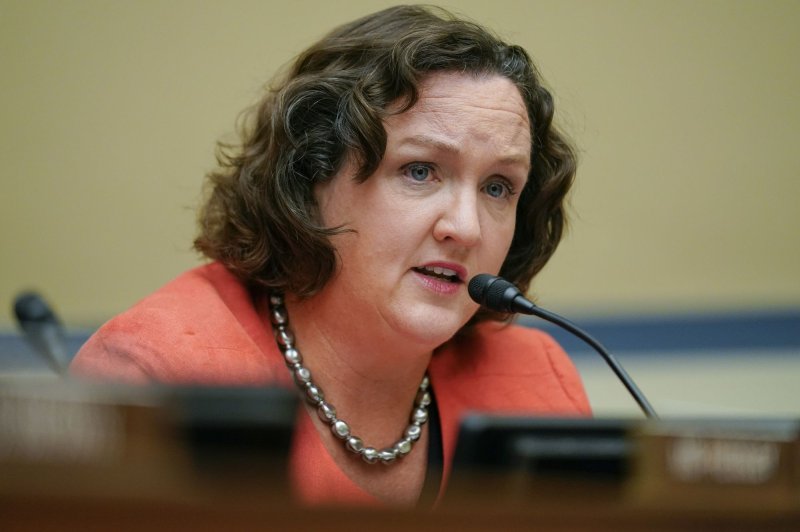Edith M. Lederer
yesterday

1 of 5
Nunay Mohamed, 25, who fled the drought-stricken Lower Shabelle area, holds her one-year old malnourished child at a makeshift camp for the displaced on the outskirts of Mogadishu, Somalia on June 30, 2022. The United States has announced $524 million in additional humanitarian aid for the Horn of Africa that aims to put a spotlight on the extreme effects of climate change and the worst drought in the region in 40 years. The aid announcement also seeks to highlight the need for more than $5 billion.

1 of 5
Nunay Mohamed, 25, who fled the drought-stricken Lower Shabelle area, holds her one-year old malnourished child at a makeshift camp for the displaced on the outskirts of Mogadishu, Somalia on June 30, 2022. The United States has announced $524 million in additional humanitarian aid for the Horn of Africa that aims to put a spotlight on the extreme effects of climate change and the worst drought in the region in 40 years. The aid announcement also seeks to highlight the need for more than $5 billion.
(AP Photo/Farah Abdi Warsameh, File)
UNITED NATIONS (AP) — A high-level U.N. conference on Wednesday raised less than $1 billion of the more than $5 billion organizers were hoping for to help over 30 million people in the Horn of Africa cope with a major climate crisis and mass displacement after years of conflict, a major disappointment to aid agencies.
The U.N. appealed for $7 billion this year to provide food and other humanitarian assistance for the three Horn of Africa countries – Somalia, Ethiopia and Kenya, and had only received $1.6 billion. After pledges were tallied, the U.N. humanitarian office said the total funding for 2023 now stands at $2.4 billion.
That means only $800 million in new funding was announced Wednesday – over 60% from the United States which made an additional donation of $524 million . That brought its total to more than $1.4 billion for the fiscal year ending Sept. 30.
U.N. Secretary-General Antonio Guterres urged would-be donors at the start of the pledging conference to make an immediate and major injection of funding to prevent the crisis caused by the longest drought on record, massive displacement and skyrocketing food prices “from turning into catastrophe.”
“People in the Horn of Africa are paying an unconscionable price for a climate crisis they did nothing to cause,” he said. “Without an immediate and major injection of funding, emergency operations will grind to a halt, and people will die.”
U.S. Ambassador Linda Thomas-Greenfield, who visited the Somali capital, Mogadishu, in September, said humanitarian needs in the Horn of Africa are now greater than ever, “with over 23.5 million persons facing acute food insecurity” which is why the U.S. has pledged additional funds.
“Right now, the global community is simply not meeting the moment,” she told the conference, warning that “the threat of famine looms.”
“In a world abundant with food, entire communities should never, never starve to death,” Thomas-Greenfield stressed.
But the results of the pledging conference co-hosted by the U.S., UK, Italy and Qatar were anything but bold.
According to the U.N. humanitarian office, there were 25 countries that made announcements along with the European Commission, Islamic Relief and the U.N.’s emergency humanitarian fund. But it said some pledges included funds for 2024 and beyond.
Germany’s U.N. Ambassador Antje Leendertse told the conference the 210 million euros ($226 million) in humanitarian aid for the three countries in 2023 and 2024 doesn’t include substantial funding “for development and stabilization” in the Horn of Africa.
UK Minister for Development and Africa Andrew Mitchell said the country pledged $119 million for the three Horn of Africa countries. In addition, he said, the UK pledged $27 million for Sudan, $23 million for South Sudan and $9 million for Uganda, taking its total new funding up to $178 million.
UNITED NATIONS (AP) — A high-level U.N. conference on Wednesday raised less than $1 billion of the more than $5 billion organizers were hoping for to help over 30 million people in the Horn of Africa cope with a major climate crisis and mass displacement after years of conflict, a major disappointment to aid agencies.
The U.N. appealed for $7 billion this year to provide food and other humanitarian assistance for the three Horn of Africa countries – Somalia, Ethiopia and Kenya, and had only received $1.6 billion. After pledges were tallied, the U.N. humanitarian office said the total funding for 2023 now stands at $2.4 billion.
That means only $800 million in new funding was announced Wednesday – over 60% from the United States which made an additional donation of $524 million . That brought its total to more than $1.4 billion for the fiscal year ending Sept. 30.
U.N. Secretary-General Antonio Guterres urged would-be donors at the start of the pledging conference to make an immediate and major injection of funding to prevent the crisis caused by the longest drought on record, massive displacement and skyrocketing food prices “from turning into catastrophe.”
“People in the Horn of Africa are paying an unconscionable price for a climate crisis they did nothing to cause,” he said. “Without an immediate and major injection of funding, emergency operations will grind to a halt, and people will die.”
U.S. Ambassador Linda Thomas-Greenfield, who visited the Somali capital, Mogadishu, in September, said humanitarian needs in the Horn of Africa are now greater than ever, “with over 23.5 million persons facing acute food insecurity” which is why the U.S. has pledged additional funds.
“Right now, the global community is simply not meeting the moment,” she told the conference, warning that “the threat of famine looms.”
“In a world abundant with food, entire communities should never, never starve to death,” Thomas-Greenfield stressed.
But the results of the pledging conference co-hosted by the U.S., UK, Italy and Qatar were anything but bold.
According to the U.N. humanitarian office, there were 25 countries that made announcements along with the European Commission, Islamic Relief and the U.N.’s emergency humanitarian fund. But it said some pledges included funds for 2024 and beyond.
Germany’s U.N. Ambassador Antje Leendertse told the conference the 210 million euros ($226 million) in humanitarian aid for the three countries in 2023 and 2024 doesn’t include substantial funding “for development and stabilization” in the Horn of Africa.
UK Minister for Development and Africa Andrew Mitchell said the country pledged $119 million for the three Horn of Africa countries. In addition, he said, the UK pledged $27 million for Sudan, $23 million for South Sudan and $9 million for Uganda, taking its total new funding up to $178 million.
Alison Huggins, deputy director for Africa for the relief organization Mercy Corps which has worked in the Horn of Africa since 2004, said it takes the results of the conference “with a grain of salt because many of these pledges were just confirmations of existing financing commitments and remain insufficient in light of the region’s urgent and expanding needs and the many lives still hanging in the balance.”
She said people in Somalia, Ethiopia and Kenya contribute less than 0.1% of global greenhouse gas emissions that cause global warming, but they are “suffering the consequences of human-induced climate change.”
The humanitarian agency CARE said the region is facing the worst food crisis in 40 years, pointing to drought, two locust invasions, conflict and rising commodity prices in the wake of Russia’s invasion of Ukraine. Over 31 million people need emergency aid, more than 2.5 million have left their homes, and on, due to the extreme weather more than 13.2 million livestock — a key money earner — have perished.
According to the U.N. humanitarian office known as OCHA, the Horn of Africa is the epicenter of one of the world’s worst climate emergencies.
Last year, an estimated 43,000 people died in Somalia, most likely due to drought – and half of the victims may have been children under the age of five, OCHA said.
While improved rains are starting to ease the impact of drought, they are also causing flooding and damage which has affected at least 900,000 people — and more flooding is expected later this year, OCHA said. And regardless of the rains, it will take years to recover from the historic drought.
In Somalia, where more than 6 million people are going hungry, a famine has yet to be declared, but some humanitarian and climate officials have warned that current trends are worse than in the 2011 famine, in which 250,000 people died.
Somalia is also grappling with insecurity due to the al-Shabab extremist group, which has ties to al-Qaida and has fought the Somali federal government in Mogadishu for years. The group intensified attacks on military bases in recent months after losing territory in rural areas to government forces.
In Ethiopia’s northern Tigray region, nearly all the 6 million people rely on food aid after two years of civil war. Government-imposed restrictions on humanitarian relief had pushed parts of the region to the brink of famine until aid deliveries resumed after the war stopped with a cease-fire in November.
But the U.N. and USAID, the U.S. aid agency, announced earlier this month that they were suspending all food assistance to investigate the theft of humanitarian supplies.
___
Associated Press writer Evelyne Musambi in Nairobi, Kenya, contributed to this report.
She said people in Somalia, Ethiopia and Kenya contribute less than 0.1% of global greenhouse gas emissions that cause global warming, but they are “suffering the consequences of human-induced climate change.”
The humanitarian agency CARE said the region is facing the worst food crisis in 40 years, pointing to drought, two locust invasions, conflict and rising commodity prices in the wake of Russia’s invasion of Ukraine. Over 31 million people need emergency aid, more than 2.5 million have left their homes, and on, due to the extreme weather more than 13.2 million livestock — a key money earner — have perished.
According to the U.N. humanitarian office known as OCHA, the Horn of Africa is the epicenter of one of the world’s worst climate emergencies.
Last year, an estimated 43,000 people died in Somalia, most likely due to drought – and half of the victims may have been children under the age of five, OCHA said.
While improved rains are starting to ease the impact of drought, they are also causing flooding and damage which has affected at least 900,000 people — and more flooding is expected later this year, OCHA said. And regardless of the rains, it will take years to recover from the historic drought.
In Somalia, where more than 6 million people are going hungry, a famine has yet to be declared, but some humanitarian and climate officials have warned that current trends are worse than in the 2011 famine, in which 250,000 people died.
Somalia is also grappling with insecurity due to the al-Shabab extremist group, which has ties to al-Qaida and has fought the Somali federal government in Mogadishu for years. The group intensified attacks on military bases in recent months after losing territory in rural areas to government forces.
In Ethiopia’s northern Tigray region, nearly all the 6 million people rely on food aid after two years of civil war. Government-imposed restrictions on humanitarian relief had pushed parts of the region to the brink of famine until aid deliveries resumed after the war stopped with a cease-fire in November.
But the U.N. and USAID, the U.S. aid agency, announced earlier this month that they were suspending all food assistance to investigate the theft of humanitarian supplies.
___
Associated Press writer Evelyne Musambi in Nairobi, Kenya, contributed to this report.














